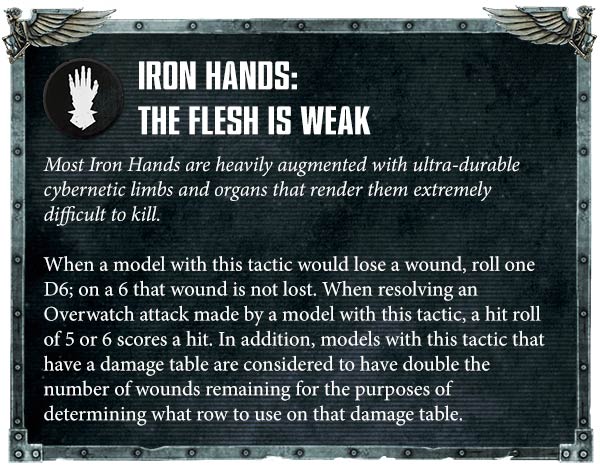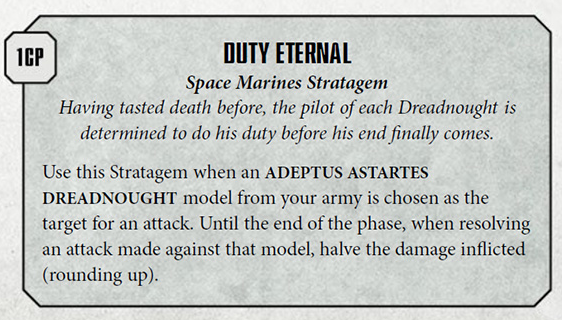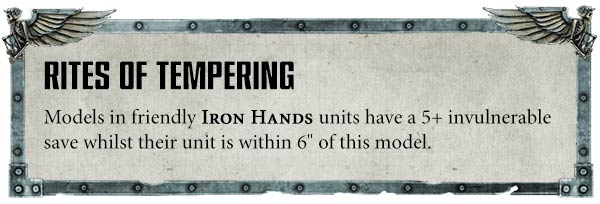Saturday saw the release of the Iron Hands rules and hoo boy, they are a doozy. Between the Hands’ Chapter Trait, the new doctrine, the Ironstone Relic, and the new warlord traits, it looks like Iron Hands are going to be a force to be reckoned with. But how good are the new rules? And what do they mean when they’re all stacked up on vehicles and ready to ruin your day? In today’s Hammer of Math, Kevin Genson is crunching the numbers to show just what it takes to take down one of these new, meta-destroying monster vehicles.
An Overview of the New Rules
Let’s start with a review of what Iron Hands already had: Their Chapter Tactic gives the entire army the ability to ignore damage taken on a 6+ (this is often referred to as a ‘6+++’). This gives every model – and more importantly for our analysis, every vehicle – an effective increase in wounds. It also gives them the ability to double the number of Wounds they have when determining which degrading profile to use, so even once you start shooting at an Iron Hands vehicle, you’ll have to take it down to 25% health to even see an impact. Finally, it allows vehicles to hit with overwatch on a 5+, but we don’t care as much about that for the purposes of this article.
The other rule that we’re going to spend a lot of time on in this article is the Duty Eternal Stratagem from the new Codex: Space Marines. This Stratagem lets a DREADNOUGHT model halve all incoming damage (rounding up) for a single phase.
OK, now let’s move on to the new stuff. Let’s start with Feirros, whose key ability (for the purposes of this article, anyways), is Rites of Tempering, which gives nearby vehicles a 5+ invulnerable save. This doesn’t mean much for the Relic Contemptors and Relic Leviathans in the army which already have invulnerable saves, but it’s potentially huge for Repulsors and Repulsor Executioners, where the addition of a 5+ invulnerable save makes them much more survivable against heavy fire.
Something that does appeal to dreadnoughts though is the new Ironstone Relic. which allows nearby vehicles to reduce incoming damage by 1. Given how the 8th edition meta has shifted its focus hard toward Damage 2 guns and weapons, the Ironstone negates all the points being spent on doing that and in many cases, may double the longevity of a vehicle. It also (currently) pairs with the Duty Eternal Stratagem to reduce incoming damage for Dreadnoughts by one half. We expect GW to release an FAQ note on the order of operations for how these two interact in the next month, but for now we’ll assume that they follow the standard mathematical order, i.e. that division happens before subtraction, and so an incoming attack doing 4 damage would be dropped to 2 by Duty Eternal, then to 1 by the Ironstone (as opposed to being dropped by 1 with the Ironstone first, then to 1.5 and rounded up to 2 by Duty Eternal).
It’s essential to understand the order of operations when looking at how Duty Eternal, the Ironstone, and similar effects such as Headman’s Mark or the Artisan of War trait interact when resolving an attack. When determining the influence of modifiers on an outcome, Games Workshop uses the standard mathematical order of operations – PEMDAS, or Parenthesis, Exponents, Multiplication/Division, Addition/Subtraction. This means that the effect of the Ironstone applies after the damage inflicted by the attack is halved by the Duty Eternal Stratagem. In contrast, the Headman’s Mark Relic applies the modifier to the Damage characteristic of the weapon, which means that the effect occurs before the damage is inflicted. In other words, when combined with Duty Eternal the Ironstone is twice as effective as comparable Relics or Traits that improve the Damage characteristic.
What does this all mean? Let’s run the numbers and find out.
Iron Hands Vehicle Survivability
Fundamentally all of this means that Iron Hands vehicles are significantly harder to kill than vehicles from other Chapters. The 6+++ effectively increases the Wounds characteristic of every unit by 20% (thanks to Michael Pestilens and Philip Swanson on the Competitive 40k Facebook group for pointing out that the bonus is 20% and not 16.7% since FNP will apply to future attempts to remove saved wounds). The incredible combination of character abilities, Relics, and Stratagems improves their resilience even further. Ultimately, our goal here is to answer the question: “How much do I have to throw at an Iron Hands Repulsor before the thing dies?” To start this analysis, I’ve chosen what will likely be a common sight in the future meta: 3 Repulsor Executioners firing 12 Heavy Laser Destroyer shots at another Repulsor.
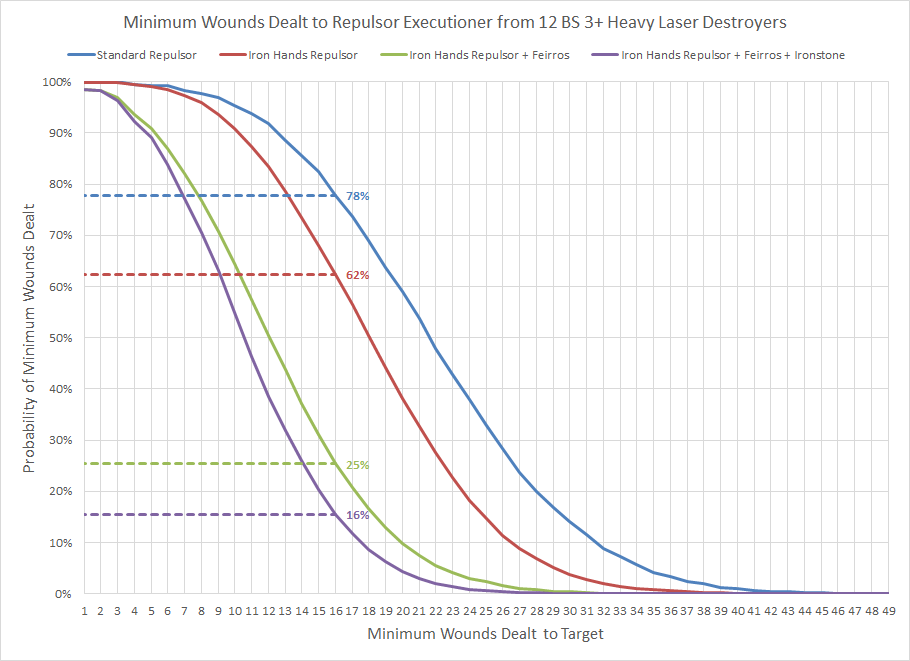
For a standard Repulsor, we can see that three Executioners firing their Laser Destroyers have a 78% chance of dealing the 16+ damage required to take out the tank. This high probability is not particularly surprising: Between the lack of an invulnerable save and having Toughness 8, the Repulsor is no match for that level of firepower. This has been a historic problem for Space Marines, particularly in an environment where Knights (with 8 Toughness and a 5+ invulnerable save that can be improved to 4+) are common, and armies have to be able to deal with them. The simple addition of a 6+ “Feel No Pain” save to the Repulsor reduces the probability of a one-volley death to 62% probability of kill; a 16% decrease from the Chapter Tactic alone. Adding Feirros is where things get particularly interesting, as the 5+ invulnerable save aura provided by the Iron Father causes the probability of a one-turn kill to plummet down to 25% as a vehicle that previously had no save against the incoming damage can now shrug off one third of the wounding shots. Finally the presence of the Ironstone provides a relatively modest decrease, bringing the final value down to 16%. Note that any army that fields Feirros is going to be healing a vehicle for at least 3 wounds a turn (and possibly as much as 6 + d3 with the appropriate psychic power and Stratagem), reducing even a partial success, while the Iron Hands’ Chapter Tactic will ensure that a vehicle with more than one fourth of its wounds remaining will still act at full effectiveness.
As it turns out however, the Repulsor is the least of your worries when facing a post-Supplement Iron Hands army. Things become even more unpleasant when you look at one of the most effective vehicles in the Spare Marine arsenal; the Leviathan Dreadnought. This living reminder of Forge World’s impact on the game’s rules merges an 8-Toughness, 14-wound chassis with a 2+ save/4+ invulnerable save and the Stratagems available to Dreadnoughts. Here things get steadily worse as you add the 6+ FNP, use Duty Eternal to cut all damage in half, and then finally use the Ironstone to reduce the damage already halved by Duty Eternal by an additional point.

Here’s a riddle for you: How do you kill an Iron Hands Leviathan? The answer: YOU DON’T. The 4+ invulnerable save made the Leviathan already vastly more survivable than the baseline Repulsor in spite of having fewer wounds but the same toughness. As with the Repulsor, the 6+ Feel No Pain roll causes a considerable reduction in the effectiveness of incoming attacks, but once you halve the damage via the Duty Eternal Stratagem the probability of dealing at least 14 wounds with a single turn of firing from 3 Executioners falls below 1%. By this point adding the Ironstone almost feels superfluous, but it should be noted that with the Ironstone Relic and the Duty Eternal Stratagem the 12 Heavy Laser Destroyer shots will deal fewer than 6 wounds to a Leviathan 90% of the time. In other words 90% of the time the damage dealt by 3 Repulsor Executioners can be fully repaired via the Iron Father and Machine Empathy in the following turn. Or just ignored since, again, it will be able to act at its full profile most of the time.
So what does it take to kill an Iron Hands Leviathan?
In order to figure out this question, I updated the simulation code I use so that it could evaluate the distribution of wounds dealt to a target and simulate how many rounds of combat it would take to deal a target number of wounds. So for example if the target was a 16-wound Repulsor, and three simulations sequentially dealt 3, 9, and 6 wounds to it, then the simulation would indicate that it took 3 rounds to kill the target. Repeat the process over 10,000 attacks and you get a decent idea of what could happen. So let’s start off our analysis with a few different common anti-vehicle weapons: A BS 3+ Lascannon, a Fire Prism firing twice, a Leman Russ firing its battle cannon twice with Grinding Advance, and a Blood Angels Smash Captain equipped with a thunder hammer and using the Red Rampage Stratagem to wail on a Leviathan in close combat.

To read this chart, find the line for the weapon you want to examine and then look up the number of attempts on the x-axis to see what the chances of that many attempts killing a Leviathan is. The dashed lines show the number of attempts that will kill the target half the time. For example, it takes around 8 rounds of combat for a Blood Angels Smash Captain to deal the 14 wounds needed to kill the Leviathan Dreadnought. That’s only an average of 64 attacks; seems perfectly fine, right? It should be noted that the combination of Duty Eternal and Ironstone Relic is particularly nasty to the poor Smash Captain’s thunder hammer; instead of doing 4 damage with each hit, the weapon will now only do 1. When facing Iron Hands armies you’re going to want to focus fire on whatever character is carrying the Ironstone first; otherwise you’re likely to be just wasting shots. Thanks to the order of operations for math (multiplication before subtraction) any weapon with damage value below 5 will only take off a single wound each time it attacks at an Iron Hands dreadnought affected by these buffs.
Things don’t get much better for the other weapons in our sample. The volume of fire provided by the battle cannon provides it with the second best benefit, with sixteen rounds of double-shooting killing the Leviathan half the time. Nineteen Fire Prism attempts using the focused fire profile will get the same result, and it will take an astonishing fifty seven lascannon shots to have a coin flip’s chance of taking out one of these resin monstrosities. The major takeaway here is that the combination of a 4++ and egregious damage reduction render the vast majority of anti-tank weapons largely useless. You’re far better off either ignoring it, taking out the supporting elements first, or applying mortal wounds (though again, it will be easy to heal these and you will have to reduce the Leviathan to 3 or fewer wounds to actually reduce its effectiveness).
Maybe we’ll be better off trying something a bit heavier?
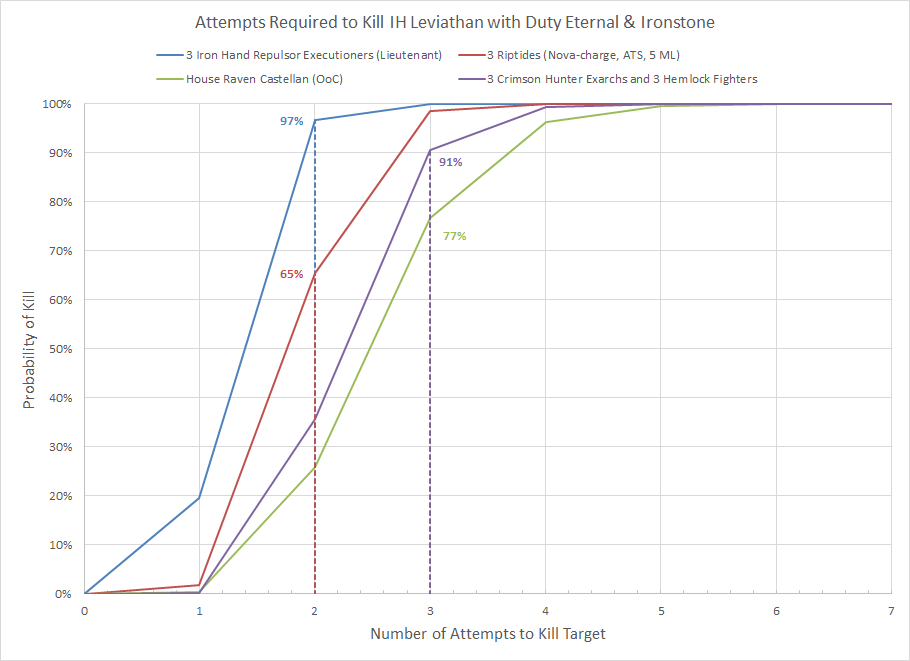
Here we see some examples of focus fire. Three Repulsors (with rerolls on 1s for both hits and wounds) will kill the Leviathan in two turns around 97% of the time. Three Riptides will only pull it off 65% of time in two turns. Things look even worse for a complete squadron of Eldar Flying Bullshit, requiring three turns to have a solid chance at killing the Leviathan. Note that this does not include the mortal wounds that the Hemlocks can produce, which will likely be the strongest source of damage. The swoopy Eldar bastards also have the best chance of taking out the Relic hauler who needs to stay close to the Leviathan to get the last bit of damage reduction. Finally we have the once-feared House Raven Castellan using Order of Companions; in spite of all of those re-rolls it needs three turns to have a decent chance of killing the dreadnought.
Screw it. Our problem is Forge World Bullshit, so let’s solve it with Forge World Bullshit. Throw a Warlord at it.
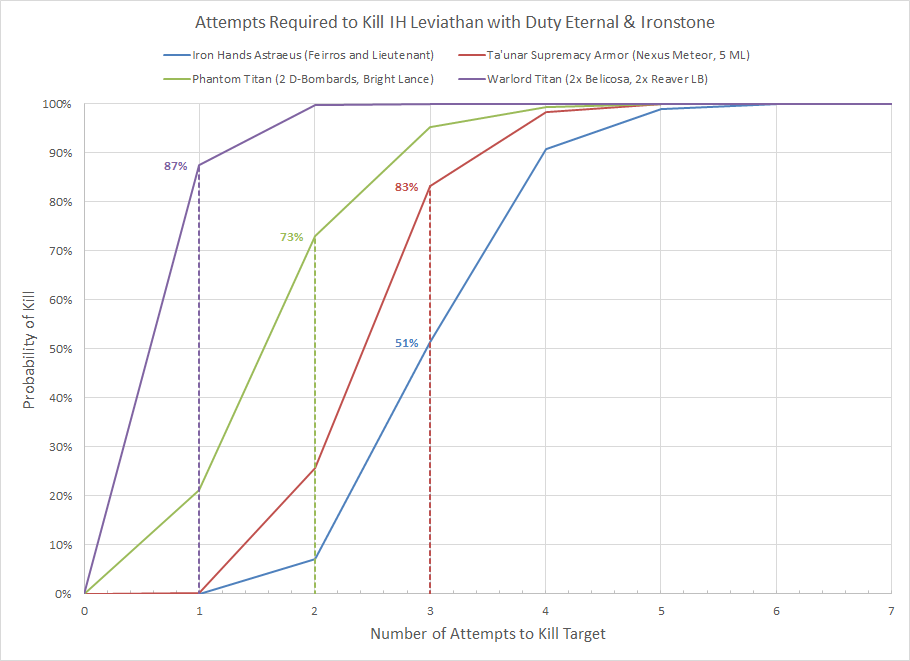
In spite of having Feirros and a Lieutenant, we see that the hilariously overcosted and undergunned Astraeus continues to be disappoint in Warhammer 40K. It’s much better in Apocalypse, but here it will take three rounds of shooting to possibly kill the Leviathan half the time. The Ta’unar Supremacy Armor fares better, giving us an 82% chance of success after three rounds. The pinnacle of Eldar Resin Bullshit, the Phantom Titan, will likely need two rounds to kill the Leviathan despite being an order of magnitude more expensive. It turns out that your best bet for slaughtering the Relic Leviathan is a Warlord Titan. 6,000 points will get you an array of city-destroying firepower that, 13% of the time, still won’t kill this stupid 14-wound walker.
Final Thoughts: Holy Shit
The new Iron Hands codex is extremely strong, and a major part of that strength comes from the increased resilience of the vehicles. Invulnerable saves, damage reduction, and Feel No Pain all individually provide a considerable increase in the ability of a unit to survive, and in this case they can all be stacked for even further improvement. Expect nearly every Iron Hands list to include the Iron Father as well as the Ironstone, and don’t be surprised when a lot of battle reports express astonishment at how much punishment a well protected Leviathan Dreadnought can take under these rules. I suspect that eventually Games Workshop will take notice and address this in a future FAQ or Chapter Approved. One way to mitigate this somewhat would be to errata the Ironstone to directly alter the Damage characteristic of the weapon (similar to how Headman’s Mark works for Imperial Knights) so that the subtraction occurs before the damage is halved.

